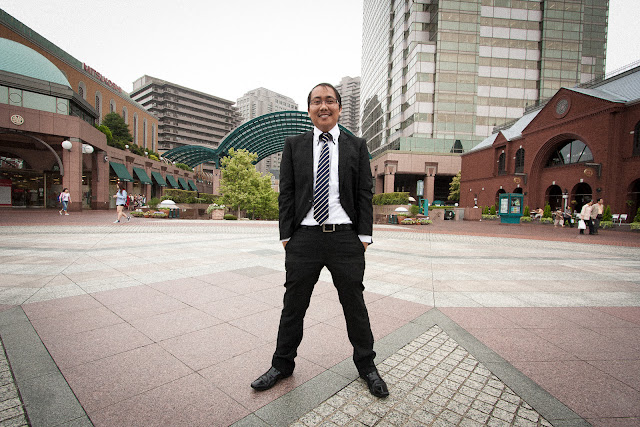To Turn the Tide
Lou Kato laughed as she
danced with the three Japanese boys of her Basic English Communication
pre-school class. "I am happy! I am happy,” said one child. No signs of
exhaustion on Lou’s face. Pulsating energy and her joyous laughter filled the
room as they danced and ran around.
Twenty-five years ago,
Lou came to Japan with the La Salle cultural dance troupe as part of a two-month
multi-cultural presentation in Kanazawa City, Ishikawa Ken. "When we came
to Japan we were treated like celebrities. They received us politely and even
gave us garlands at the airport", she recalled.
This was just a few
years before the influx of Filipino entertainers began. At the time, musicians
and performers were mostly seen at first class hotels. In the 1990s, the number
of Filipino entertainers surged from around 9,000 in 1986 to approximately
60,000 in 1991. Their work somehow evolved from plain stage performances to
pouring drinks to their customers to suspicion of prostitution. Bad reports
involving entertainers as well as human trafficking issues gave Filipinas in
Japan questionable reputation.
Lou danced with her
group for three years until she married Ken Kato, her promoter, and settled as
a housewife in Hamamatsu City, Shizuoka Ken. “My in-laws were shocked at first
because they did not know how to interact with me,” she recalled. The next
year, she gave birth to a daughter, Yuko.
When Yuko was three
years old, Lou enrolled her in one of the biggest English schools in Hamamatsu.
She wanted to make sure that Yuko would speak fluent English so she could
communicate with her family in the Philippines. When Lou went to observe a
class, she was dumbfounded. "The teacher spoke fluent English to me but
when she spoke to the class she blurted out...Harrooo (Hello)in Japanese,” she
said.
Lou took that as a
challenge. She decided to start her own school. She searched for English
teachers training courses and attended several Oxford University Press seminars
in Tokyo. She got her license in teaching methods at the IIEEC-OUP Teacher
Training Center and with LATEM. That is how Basic English Conversation (BEC)
Kyoushitsu was born.
At first there were only
three students. Now there are several classes for different grade levels and
adults. “Two, of my first batch of students, are now studying at Waseda
University. And they never fail to visit me whenever they are in Hamamatsu,”
she said with a smile.
"The school's goal
is simple. We aid the parents of elementary pupils to achieve goals for their
children. Such as to pass the Eiken (Practical English Proficiency Test) or to
have them enrolled at public schools. That is where we do our best," she added.
Now she also works as an
ALT (Assistant Language Teacher) to different primary schools. Teaching in
primary schools is a totally different experience for her. Some students
complain. Some say English is “difficult.” Some say,” learning English is of no
use.”
It is not only the
students that give her a hard time. One time, an indifferent, old Japanese
teacher, interrupted her in the middle of a teaching session and shouted,
"Stop!" Shocked, Lou immediately stopped as the teacher tactlessly
took over. She was crying inside the car as she headed back home.
At her own school, the
children open up to her. "God
has a purpose for me. It is not just English that they need. They need love and
time", she believes, "Always listen to them". Once in a while,
she would serve as a mediator between parent and high school students who have
deep personal problems. Sometimes, some of these problems go as deep as
committing suicide. "In situations like these my role shifts. I become
their second parent," she says. "I would then encourage them to
pray." This is where she draws her happiness.
Lou is also an
interpreter at the Hamamatsu government lawyers' office. She also serves as one
of the Filipino representatives of HICE (Hamamatsu Foundation for International
Communications and Exchanges). During multi-cultural events she gives speeches
about the Philippines and its culture. And for seven years now, she coordinates
with LATEM (Little America Teaching English Method) and lectures on how to
teach English in Japan.
It has been a tough
journey. Oftentimes, she meets Japanese who are still prejudiced against her
Filipino heritage and past career as an entertainer. Her response is simple,
“Persevere, understand the culture and be patient.” She then excused herself as
her new student, an old Japanese teacher whom she used to work with arrived.



Nice one, Rad. I like the narrative frame you're drawing to ground the reader back in presence. At times I thought that maybe it has a few too many abbreviations, but I'm guessing that's something you can't circumvent. Overall I'm guessing you could have made it a lot longer, but I think for the brevity of it it's nicely structured and reads easily.
ReplyDeleteThank you Thomas. The original story is longer than this one. We were limited to 650 words.
ReplyDelete